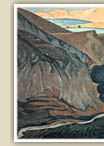|
Around 1909, Konstantinos Parthenis came to figure in Greek painting; in the inter-war period, when he was elevated to a teacher
of Modern Greek painting, he would dominate.
|

Parthenis introduced Impressionism to Greece, thereby renewing the means of artistic expression and synthesizing European movements with the tradition of Hellenism.
In his work he integrated modern Greek painting into modern art, breaking at the same
time certain of its forms.
Impressionist and post-impressionist elements, the anti-Realistic tendency and a
personal symbolism constituted a peculiarly spiritual art, in which the
intentions of the artist are realized by means of an original technique.
He was interested more in works of a historical, religious, mythological and allegorical
character.
Konstantinos Maleas offered a new approach to landscape painting. He proceeded from the representation of
natural space to its interpretation. Redefining the role of colour, with an intense
stylization of form, a strict organization of design, he created a Greek landscape that imposed itself on the spectator.
Yorgos Bouzianis, with his interest in human form, created
work that reflected the influence of German Expressionism upon a different
'Mediterranean Greek Expressionism', as Chr. Christou observes, with strong
personal elements. His work featured lyrical colours and the
inwardness of figures. His work is among the more (if not the most)
important manifestations of Expressionism outside Germany.
|
 |
